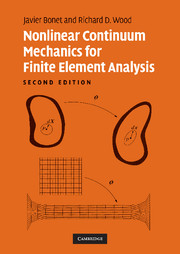Book contents
- Frontmatter
- Contents
- Preface
- 1 INTRODUCTION
- 2 MATHEMATICAL PRELIMINARIES
- 3 ANALYSIS OF THREE-DIMENSIONAL TRUSS STRUCTURES
- 4 KINEMATICS
- 5 STRESS AND EQUILIBRIUM
- 6 HYPERELASTICITY
- 7 LARGE ELASTO-PLASTIC DEFORMATIONS
- 8 LINEARIZED EQUILIBRIUM EQUATIONS
- 9 DISCRETIZATION AND SOLUTION
- 10 COMPUTER IMPLEMENTATION
- Bibliography
- Index
3 - ANALYSIS OF THREE-DIMENSIONAL TRUSS STRUCTURES
Published online by Cambridge University Press: 06 July 2010
- Frontmatter
- Contents
- Preface
- 1 INTRODUCTION
- 2 MATHEMATICAL PRELIMINARIES
- 3 ANALYSIS OF THREE-DIMENSIONAL TRUSS STRUCTURES
- 4 KINEMATICS
- 5 STRESS AND EQUILIBRIUM
- 6 HYPERELASTICITY
- 7 LARGE ELASTO-PLASTIC DEFORMATIONS
- 8 LINEARIZED EQUILIBRIUM EQUATIONS
- 9 DISCRETIZATION AND SOLUTION
- 10 COMPUTER IMPLEMENTATION
- Bibliography
- Index
Summary
INTRODUCTION
This chapter considers the uniaxial (one-dimensional) large-displacement, largestrain, rate-independent elasto-plastic behavior applicable to structural analysis of pin-jointed trusses. The motivation is to expand and reinforce previous material and to introduce some topics that will reappear later when elasto-plastic behavior of continua is considered. For example, various nonlinear geometrical descriptors will be linearized providing further examples of the use of the directional derivative.
Formulations start with the kinematic description of the motion in three dimensional space of a truss member (axial rod) that undergoes large displacements and rotations leading to large or small strain that causes stress which may reach the limit or yield stress of the material. For simplicity, it will be assumed that the strain in the truss member is uniform. Consequently, the fundamental measure of deformation in the axial rod is the stretch λ = l/L, which is the ratio of the deformed length to the undeformed length, see Figure 3.1.
The internal forces in the truss are easily determined from simple strength of- material considerations involving the true (or Cauchy) stress, σ, defined for a truss as the internal axial force, T, divided by the deformed cross-sectional area, a. However, for large deformation the elasto-plastic behavior is best characterized using an alternative stress known as the Kirchhoff stress, τ, defined as συ/V, see Figure 3.1. In preparation for Chapter 6 it will be shown how the Kirchhoff stress can be derived from a hyperelastic energy function involving the natural logarithm of the stretch.
- Type
- Chapter
- Information
- Publisher: Cambridge University PressPrint publication year: 2008

